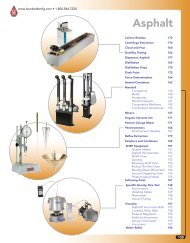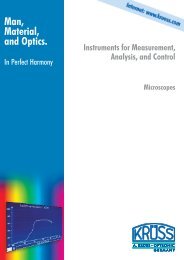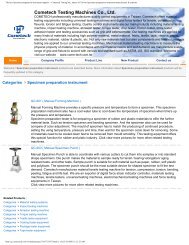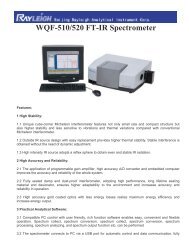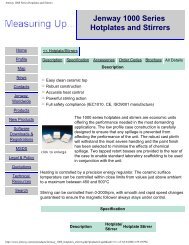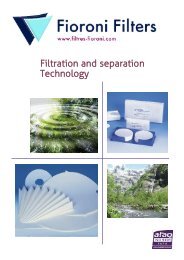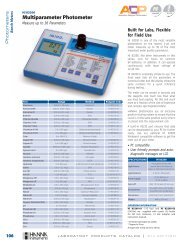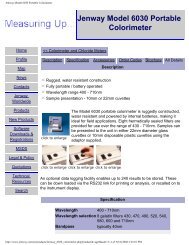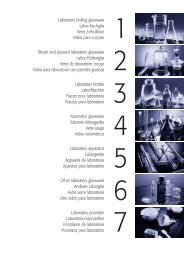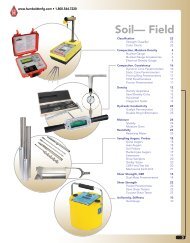Esco Labculture® Plus Class II Type A2 Biosafety Cabinet - Comlibris
Esco Labculture® Plus Class II Type A2 Biosafety Cabinet - Comlibris
Esco Labculture® Plus Class II Type A2 Biosafety Cabinet - Comlibris
You also want an ePaper? Increase the reach of your titles
YUMPU automatically turns print PDFs into web optimized ePapers that Google loves.
Operator, Product and Environmental Protection<br />
The <strong>Esco</strong> Labculture <strong>Class</strong> <strong>II</strong>, <strong>Type</strong> B2 <strong>Biosafety</strong> <strong>Cabinet</strong><br />
provides operator, product and environmental protection<br />
against <strong>Biosafety</strong> Levels 1, 2 and 3. This cabinet can be<br />
used for handling Biohazard Level 4, provided that the<br />
operator wears positive pressure suit.<br />
Containment and Protection<br />
• The total exhaust design of the LB2 makes<br />
the cabinet suitable for microbiological<br />
work involving trace amounts of toxic<br />
chemicals.<br />
• The non-recirculating design guarantees<br />
safety in cases where exhaust HEPAfiltration<br />
fails to ensure containment.<br />
• Inflow of room air enters the front air<br />
grille to establish operator protection;<br />
room air does not enter the work zone,<br />
preventing product contamination.<br />
• The front grille has proportionally larger<br />
perforation on the extreme left and<br />
right side. Combined with the side air<br />
gap between the work tray and the side<br />
wall, the stronger side capture zones<br />
increase protection in this critical area<br />
where contaminants tend to bleed out<br />
in conventional cabinet.<br />
• The inflow grille has a convex shape<br />
to maintain operator protection by<br />
discouraging users from placing objects<br />
on it.<br />
• Raised armrest prevents the likelihood of<br />
inflow grille blocking by operator’s arms.<br />
• Auto-purge holes located at the front<br />
side walls eliminate eddy currents and<br />
dead air pockets in the critical area<br />
behind the sash window. Per NSF / ANSI<br />
49 requirement, these side perforations<br />
do not extend completely to the work<br />
surface to prevent accidental liquid<br />
spills in the work zone from entering<br />
the side air column.<br />
• The ULPA downflow (supply) filter is<br />
tilted proportional to the cabinet front<br />
angle to direct more air forward to the<br />
front air grille.<br />
• The inflow velocity, downflow velocity,<br />
and air flow path, and intake geometry<br />
are precision tuned and tested to<br />
create an optimum air curtain on the<br />
front aperture; this curtain maintains<br />
personal and product protection<br />
even in the unlikely event of a severe<br />
inflow or downflow imbalance that<br />
would compromise protection in a<br />
conventional cabinet.<br />
Integrated Filtration System<br />
A combination of a supply ULPA filter and<br />
an exhaust HEPA filter give the Labculture<br />
cabinet a fully integrated performance<br />
envelope for product, operator and<br />
environmental protection.<br />
• ULPA supply filter (per IEST-RP-<br />
CC001.3), is tested to a typical efficiency<br />
of >99.999% for 0.1 to 0.3 micron<br />
particles; providing better filtration<br />
capability than conventional HEPA<br />
filters that have a typical efficiency of<br />
> 99.99% for 0.3 micron particles.<br />
• HEPA exhaust filter (per IEST-RP-<br />
CC001.3), is tested to a typical efficiency<br />
of >99.99% for 0.3 micron particles.<br />
Mini-pleat Separatorless Filter (left) vs.<br />
Conventional Aluminium Separator Filter (right)<br />
<strong>Esco</strong> cabinets use Swedish Camfil Farr ® mini-pleat<br />
filters without aluminum separators to increase filter<br />
efficiency, minimize the chance of leakage, and to<br />
prolong filter life. Filters include a lightweight<br />
aluminum frame for structural stability and<br />
elimination of swelling common to conventional<br />
wood frames.<br />
<strong>Esco</strong> ULPA Filter Efficiency<br />
Typical Penetration<br />
• Modern separator-less mini-pleat filter<br />
construction maximizes the filter surface<br />
area to extend filter life and eliminate<br />
possible filter media damage by thin<br />
and sharp aluminum separators used in<br />
conventional HEPA filter construction.<br />
• The filter frame and media is constructed<br />
in accordance with EN1822 requirements<br />
for fire retardant properties<br />
• The supply ULPA filter provides ISO <strong>Class</strong><br />
3 (per ISO14644.1) clean air to the work<br />
surface in a gentle vertical laminar flow<br />
for product protection.<br />
• The exhaust HEPA filter traps biohazard<br />
particles acquired from the work surface<br />
before air is exhausted via the ducting<br />
system to the external environment. The<br />
Model LB2 is provided with an integral<br />
exhaust collar for connecting the cabinet<br />
exhaust to an airtight ducting system.<br />
NB: Ductworks are not provided with<br />
standard product.<br />
Front Sash Assembly<br />
• Integrated sash proximity contacts sense<br />
sash position, serve as an interlock for<br />
the UV lamp, and activate an alarm if<br />
the sash is improperly positioned.<br />
• The magnetic switch eliminates the<br />
chance of mechanical wear and tear<br />
typical of a mechanical switch.<br />
• The back of the sash can be easily<br />
cleaned by removing the sash track<br />
cover and swing up the sash glass.<br />
• The sash is counterbalanced for smooth<br />
and light sash moving operation.<br />
• The counterbalance locking mechanism<br />
is inherently safe; it locks the counterbalance<br />
in place if either of the 2 cables<br />
is detached. The sash cable and cable<br />
clip have rated strength of more than<br />
6x the weight of the sash window of<br />
the largest Labculture <strong>Class</strong> <strong>II</strong> cabinet<br />
(1.8 meter/6 ft model)<br />
• The safety glass maintains containment<br />
if the sash is accidentally broken during<br />
cabinet operation.<br />
<strong>Esco</strong> cabinets use ULPA filters (per<br />
IEST-RP-CC001.3) instead of conventional<br />
HEPA filters commonly found in<br />
biological safety cabinets. While HEPA<br />
filters offer 99.99% typical efficiency<br />
at 0.3 micron level, ULPA filters provide<br />
99.999% typical efficiency for particle<br />
sizes of 0.1 to 0.3 micron level.



